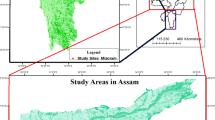Abstract
This study determined existing quantitative stand structure and its implication on silvicultural management of homestead forestry. The results showed that fruit and timber species have importance values of 57% and 43%, respectively, in the study area, which is in contrast to the commonly held view of absolute domination of fruit species. The fruit species were only moderately dominant over timber species in relation to the quantitative stand structure of homestead forests. Two fruit species, Mangifera indica and Artocarpus heterophyllus, contribute about one third of the stand structure, while amongst the timber species Samanea saman and Albizia spp. are the most important species. A simulated evaluation of soil expectation value of homestead forest showed that the existing stand structure would not maximize the financial gain perpetually, in contrast, the quantitative stand structure could be effectively regulated to maximize grower benefit without compromising the existing biodiversity. Optimization of the quantitative stand structure of homestead forests could be achieved by changing the species composition, specifically by increasing the percentage of commercially valuable species like Michelia champaca, Tectona grandis, Artocarpus chapalasha, Gmelina arborea, Litchi chinensis, Citrus grandis, Psidium guajava, Lagerstroemia speciosa, Swietenia mahogany, etc., reducing the percentage of species like Mangifera indica, Artocarpus heterophyllus, Cocos nucifera, Samanea saman, Spondias pinnata, Phoenix sylvestris, etc., and eradicating species like Lannea coromandelica and Ficus benghalensis. It was estimated that the optimal relative density of fruit and timber species that would generate optimal financial benefit would be 40.4% and 59.6%, respectively.
Similar content being viewed by others
References
Abedin MA, Lai CK, Ali MO (1988) Homestead plantation and agroforestry in Bangladesh. BARI/RWEDP/Winrocks. Dhaka, Bangladesh
Arnold IEM (1992) Production of forest products in agricultural and common land system: economic and policy issues. In: Sharma NP (ed) Managing the world’s forests. World Bank, Washington, DC. pp 313–415
Bangladesh Bank (2002) Monthly economic trends. December 2002, Dhaka, Bangladesh
InstitutionalAuthorNameBangladesh Bureau of Statistics (1996) Bangladesh population census 1991, community series zila: Sylhet Bangladesh Bureau of Statistics Dhaka, Bangladesh
InstitutionalAuthorNameBangladesh Bureau of Statistics (2003) Statistical year book of Bangladesh 2001 Bangladesh Bureau of Statistics Dhaka, Bangladesh
Christanty L (1985) Homegardens in tropical Asia: a special reference to Indonesia. Paper presented at the First International Workshop on Tropical Homegardens. Institute of Ecology, Padjadjaran University, Bandung, Indonesia
Das DK (1990) List of Bangladesh village tree species. Forest Research Institute, Chittagong (Mimeo), p 11
LS Davis KN Johnson PS Bettinger TE Howard (2001) Forest management: to sustain ecological, economic, and social values EditionNumber4th edn. McGraw-Hill New York
Government of Bangladesh (1992) Forestry master plan. Participatory forestry. Government of Bangladesh, Ministry of Environment and Forests, Dhaka, Bangladesh
Government of Bangladesh (1999) Sylhet Forest Division at a glance (in Bengali). Sylhet Forest Division, Sylhet, Bangladesh
Leuschner WA, Khaleque K (1987) Homestead agroforestry in Bangladesh. In: Nair PKR (ed) Agroforestry systems in the tropics. ICRAF, pp 197–209
Nair PKR (1989) Food producing trees in agroforestry systems. In: Agroforestry Systems in Tropics. ICRAF, pp 542–551
EP Odum (1971) Fundamentals of ecology EditionNumber3rd edn Toppan Tokyo
Raintree SB (1991) Socio-economic attributes of tree planting practices, community forestry notebook-9. FAO/ICRAF, Rome, p 59
Shukla RS, Chandel PS (1998) Plant ecology and soil science. Chand, New Delhi, India
Author information
Authors and Affiliations
Corresponding author
About this article
Cite this article
Motiur, R., Tsukamoto, J., Furukawa, Y. et al. Quantitative stand structure of woody components of homestead forests and its implications on silvicultural management: a case study in Sylhet Sadar, Bangladesh. J For Res 10, 285–294 (2005). https://doi.org/10.1007/s10310-004-0137-4
Received:
Accepted:
Issue Date:
DOI: https://doi.org/10.1007/s10310-004-0137-4




